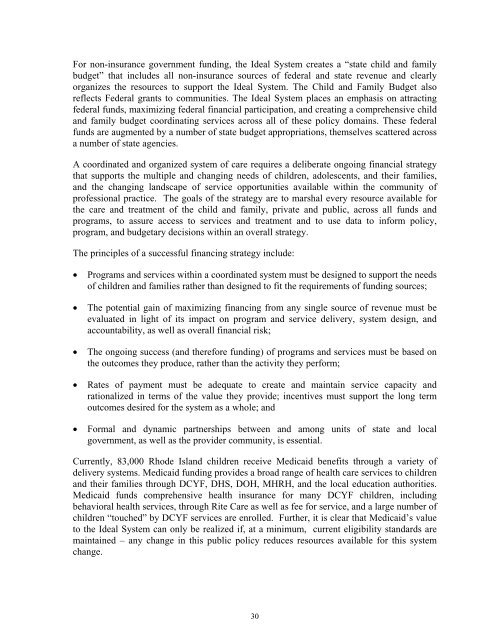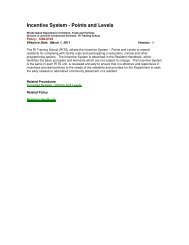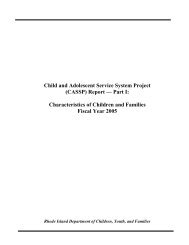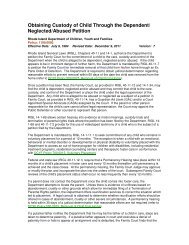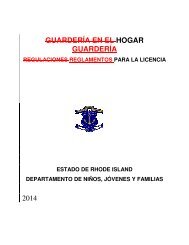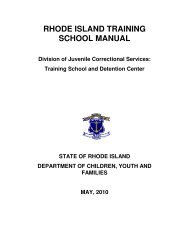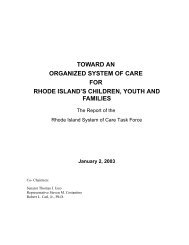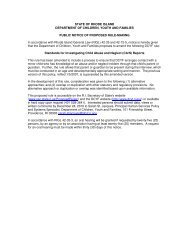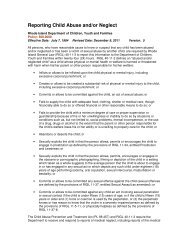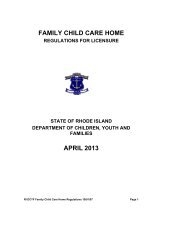system of care for rhode island's children, youth and families
system of care for rhode island's children, youth and families
system of care for rhode island's children, youth and families
You also want an ePaper? Increase the reach of your titles
YUMPU automatically turns print PDFs into web optimized ePapers that Google loves.
For non-insurance government funding, the Ideal System creates a “state child <strong>and</strong> family<br />
budget” that includes all non-insurance sources <strong>of</strong> federal <strong>and</strong> state revenue <strong>and</strong> clearly<br />
organizes the resources to support the Ideal System. The Child <strong>and</strong> Family Budget also<br />
reflects Federal grants to communities. The Ideal System places an emphasis on attracting<br />
federal funds, maximizing federal financial participation, <strong>and</strong> creating a comprehensive child<br />
<strong>and</strong> family budget coordinating services across all <strong>of</strong> these policy domains. These federal<br />
funds are augmented by a number <strong>of</strong> state budget appropriations, themselves scattered across<br />
a number <strong>of</strong> state agencies.<br />
A coordinated <strong>and</strong> organized <strong>system</strong> <strong>of</strong> <strong>care</strong> requires a deliberate ongoing financial strategy<br />
that supports the multiple <strong>and</strong> changing needs <strong>of</strong> <strong>children</strong>, adolescents, <strong>and</strong> their <strong>families</strong>,<br />
<strong>and</strong> the changing l<strong>and</strong>scape <strong>of</strong> service opportunities available within the community <strong>of</strong><br />
pr<strong>of</strong>essional practice. The goals <strong>of</strong> the strategy are to marshal every resource available <strong>for</strong><br />
the <strong>care</strong> <strong>and</strong> treatment <strong>of</strong> the child <strong>and</strong> family, private <strong>and</strong> public, across all funds <strong>and</strong><br />
programs, to assure access to services <strong>and</strong> treatment <strong>and</strong> to use data to in<strong>for</strong>m policy,<br />
program, <strong>and</strong> budgetary decisions within an overall strategy.<br />
The principles <strong>of</strong> a successful financing strategy include:<br />
• Programs <strong>and</strong> services within a coordinated <strong>system</strong> must be designed to support the needs<br />
<strong>of</strong> <strong>children</strong> <strong>and</strong> <strong>families</strong> rather than designed to fit the requirements <strong>of</strong> funding sources;<br />
• The potential gain <strong>of</strong> maximizing financing from any single source <strong>of</strong> revenue must be<br />
evaluated in light <strong>of</strong> its impact on program <strong>and</strong> service delivery, <strong>system</strong> design, <strong>and</strong><br />
accountability, as well as overall financial risk;<br />
• The ongoing success (<strong>and</strong> there<strong>for</strong>e funding) <strong>of</strong> programs <strong>and</strong> services must be based on<br />
the outcomes they produce, rather than the activity they per<strong>for</strong>m;<br />
• Rates <strong>of</strong> payment must be adequate to create <strong>and</strong> maintain service capacity <strong>and</strong><br />
rationalized in terms <strong>of</strong> the value they provide; incentives must support the long term<br />
outcomes desired <strong>for</strong> the <strong>system</strong> as a whole; <strong>and</strong><br />
• Formal <strong>and</strong> dynamic partnerships between <strong>and</strong> among units <strong>of</strong> state <strong>and</strong> local<br />
government, as well as the provider community, is essential.<br />
Currently, 83,000 Rhode Isl<strong>and</strong> <strong>children</strong> receive Medicaid benefits through a variety <strong>of</strong><br />
delivery <strong>system</strong>s. Medicaid funding provides a broad range <strong>of</strong> health <strong>care</strong> services to <strong>children</strong><br />
<strong>and</strong> their <strong>families</strong> through DCYF, DHS, DOH, MHRH, <strong>and</strong> the local education authorities.<br />
Medicaid funds comprehensive health insurance <strong>for</strong> many DCYF <strong>children</strong>, including<br />
behavioral health services, through Rite Care as well as fee <strong>for</strong> service, <strong>and</strong> a large number <strong>of</strong><br />
<strong>children</strong> “touched” by DCYF services are enrolled. Further, it is clear that Medicaid’s value<br />
to the Ideal System can only be realized if, at a minimum, current eligibility st<strong>and</strong>ards are<br />
maintained – any change in this public policy reduces resources available <strong>for</strong> this <strong>system</strong><br />
change.<br />
30


